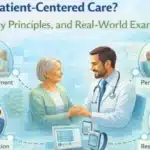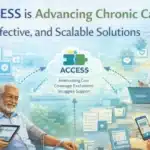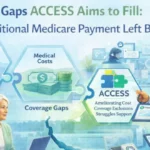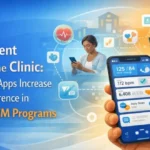A Complete Guide to Remote Therapeutic Monitoring (RTM) & Latest Billing Codes

Remote Therapeutic Monitoring (RTM) combines FDA‑approved devices (like smart inhalers, wearable sensors, and therapy apps) with CMS‑recognized CPT codes (98975–98981) to track therapy adherence, patient‑reported outcomes, and behavioral health data — improving care quality and creating new revenue opportunities
Remote Therapeutic Monitoring (RTM) is changing how providers monitor and support patients outside of traditional clinical care settings. RTM is a program established by the Centers for Medicare & Medicaid Services (CMS) that allows for monitoring patients’ adherence to therapeutic regimens and behavioral health.
RTM helps a provider ensure a patient follows their therapeutic plan, including physical therapy exercises, proper inhaler technique using an inhaler, or adhering to using a mental health app while monitoring their usage and engagement over time. Also, RTM enables providers to monitor adherence and progress, identify any lapses or misses, potentially intervene before a major gap in the therapeutic process occurs, and improve outcomes for chronic and acute condition management.
As of 2025, it is not only available to physicians but also to non-physician qualified healthcare professionals, including physical therapists, occupational therapists, speech-language pathologists, and mental health providers.
Table of Contents
ToggleHow RTM Differs from Remote Patient Monitoring (RPM)?
Although both RTM and RPM are classified as remote care services by CMS, they differ significantly in their structure, eligible use cases, and billing regulations. RTM is different from Remote Patient Monitoring (RPM) in a way that RPM measures blood pressure or glucose levels, while RTM is a platform for monitoring musculoskeletal conditions, respiratory therapy, cognitive behavioral health, and other treatments that are not focused on vital sign monitoring.
RPM primarily focuses on the collection and interpretation of physiological data. This data is automatically gathered and transmitted through FDA-approved medical devices such as blood pressure monitors, weight scales, glucose meters, and pulse oximeters. In contrast, RTM focuses on data related to therapy adherence, symptoms, medication behavior, and cognitive or functional status. Also, RTM allows for self-reported data that is uploaded by a patient and then medically reviewed by a qualified healthcare provider. RTM covers wider therapeutic areas, including non-physiological conditions requiring therapy such as mental health or musculoskeletal disorders.
Another key difference lies in staffing requirements: RPM services may be delivered by clinical staff under general supervision, whereas RTM services must be provided by qualified healthcare professionals under direct supervision.
2025 CPT Codes for Billing RTM Services (98975–98981)
The six RTM CPT codes, classified as general medicine codes include:
98975: This code involves initial setup and patient education. Remote therapeutic monitoring (e.g., respiratory system status, musculoskeletal system status, therapy adherence, therapy response); initial set-up and patient education on use of equipment.
Billed only once at the start of the consultation, the reimbursement amount for CPT Code 98975 is $19.65*
98976: This code involves monthly data transmission and supply of devices for monitoring the Respiratory System. Remote therapeutic monitoring (e.g., respiratory system status, therapy adherence, therapy response); device(s) supply with scheduled (e.g., daily) recordings and/or programmed alert transmissions to monitor the respiratory system.
Billed once every 30 days, the reimbursement amount for CPT Code 98976 is $46.83*
98977: This code involves monthly data transmission and supply of device for monitoring Musculoskeletal System. Remote therapeutic monitoring (e.g., musculoskeletal system status, therapy adherence, therapy response); device(s) supply with scheduled (e.g., daily) recording(s) and/or programmed alert(s) transmission to monitor musculoskeletal system.
Billed once every 30 days, the reimbursement amount for CPT Code 98977 is $46.83*
98978: This code involves monthly data transmission and supply of device for monitoring Cognitive Behavioral Therapy. Remote therapeutic monitoring (e.g., cognitive behavioral therapy, therapy adherence, therapy response); device(s) supply with scheduled (e.g., daily) recording(s) and/or programmed alert(s) transmission to monitor cognitive behavioral therapy.
Billed once every 30 days, the reimbursement amount for CPT Code 98978 is not specified and will be priced by the carrier.
98980: CPT 98980 describes treatment management services for remote therapeutic monitoring that are given by a physician or other certified healthcare practitioner. This code is used when a clinician spends at least 20 minutes every calendar month, including at least one interactive communication with the patient or caregiver, reviewing and monitoring data on the patient’s reaction to therapy and managing their treatment plan.
Billed every calendar month, the reimbursement amount for CPT Code 98980 is $49.78*
98981: CPT 98981 is used to report each additional 20 minutes of treatment management services for remote therapeutic monitoring performed by a physician or other qualified healthcare practitioner. This code applies when there is at least one interactive communication with the patient or caregiver during the calendar month, in addition to the initial 20 minutes of therapy management. Billed every calendar month, the reimbursement amount for CPT Code 98981 is $39.29*
*Reimbursement rates for RTM codes will vary depending on the region.
Who Can Bill for RTM?
Physicians and other qualified healthcare providers are permitted to bill RTM, including:
- Physical therapists
- Occupational therapists
- Speech-language pathologists
- Physician assistants
- Nurse practitioners
- Psychologists
RTM is a general medicine code rather than an E/M code, hence there is billing under general supervision allowed. Also, RTM services must be performed directly by the billing practitioner, or in the case of physical therapy under the supervision of the physical therapist or (PT) occupational therapist (OT).
How Often Can RTM Codes Be Billed?
All six codes available for billing RTM have different billing frequencies that can occur concurrently or coincide throughout an episode of care (EOC).
- Code 98975 may be billed once per episode of care (EOC), starting when remote therapeutic monitoring services begin.
- Codes 98976, 98977, and 98978 may be billed once every 30 days.
- Code 98980 may be billed once per calendar month for the first 20 minutes of treatment management, regardless of the number of therapeutic monitoring modalities used.
- Code 98981 may be billed once per calendar month for each additional 20-minute increment of treatment management. This code can be billed multiple times in the same month for successive 20-minute blocks.
- Codes 98980 and 98981 are treatment management codes that account for the time a licensed healthcare professional spends monitoring patient data. These codes are calendar-month-specific, time-dependent, and necessitate at least one synchronous communication session, such as a phone call.
Billing and Reimbursement: Best Practices
To ensure proper reimbursement, providers must:
- Track data days accurately: Only submit supply codes if the patient used the device for 16+ days in a 30-day period.
- Document synchronous interaction: Codes 98980 and 98981 require at least one real-time patient communication (phone or video).
- Avoid dual billing: RPM and RTM services cannot be billed for the same patient within the same calendar month.
- Use proper therapy modifiers: For therapists, add GP, GO, or GN modifiers based on the provider type to ensure correct categorization.
- Segment care minutes: If providing RTM alongside CCM or BHI, ensure each program’s time is tracked and billed separately.
By following these practices, providers reduce the risk of payer rejection and build a sustainable revenue stream around RTM services.
RTM Use Cases Across Clinical Specialties
RTM use cases are gaining traction in many specialties beyond the orthopedic and pulmonary settings including:
- Physical Therapy & Orthopedics: Tracking post-operative range of motion, adherence to daily exercise, and outcomes for recovery after joint replacement or sports injury.
- Pulmonology: Monitoring inhaler use, adherence to respiratory therapy, and symptoms related to COPD, asthma and post-COVID lung recovery.
- Behavioral Health: Tracking engagement in CBT (Cognitive Behavioral Therapy), mood tracking, adherence to meditation practice, and use of mental health apps.
- Chronic Pain Management: Leveraging digital diaries and wearables to log pain, medication adherence, triggers of flare-ups, and lifestyle habits.
- Women’s Health: Supporting pelvic floor therapy or postpartum recovery exercises via real-time feedback and adherence tracking.
- Weight Management and Nutrition: Tracking eating, meal plan adherence (weight management, diabetes, and metabolic syndrome), tracking exercise, and emotional eating behavior.
- Speech Therapy: Monitoring adherence to speech exercises, vocal practice, and functional communication for patients recovering from stroke or neurological conditions.
The ability to modify RTM to fit these and other therapeutic situation supports the ability for care teams to capture longitudinal insights into patient behavior between visits.
Advanced Clinical Applications of RTM
RTM is not just a billing opportunity; it is a clinical instrument that can help improve the outcomes. For instance, as mentioned previously, orthopedic clinics are using RTM devices at home, by wearing them. Those devices measure the range of motion, measure the number of times the patient engages in rehab-based exercise, measure pain levels, and the physical therapist has now in-between physical visits the ability to adjust their care plan.
In pulmonary care, there are smart inhalers and other respiratory apps that allow patients to log when they use their inhaler, track symptoms of wheezing or chest tightness, and receive a notification from the app reminding them to take their medication. For asthma or COPD patients, this means fewer times in the ER and better adherence to medication regimens.
Behavioral health practices are also using RTM in their practices. CBT-based platforms provide modules aimed at patients to engage with every day provided there is not a severe life emergency going on. The modules allow clinicians to generate measurable data about patient participation and engagement trends which will function as valuable discussion points in subsequent visits.
In pain management, patients report their pain flare-ups, identifying the limitations of their activity, and report any medication side effects. Providers can reassess treatment or make referrals to behavioral pain programs before there is a crisis.
RTM is most effectively employed when it is a part of a feedback loop; data is collected and acted upon. It is incumbent upon providers to review RTM data and intervene going forward in order to achieve the outcomes anticipated by CMS and commercial payers.
In pediatric care, Remote Therapeutic Monitoring supports children receiving therapy from therapies related to asthma or ADHD therapy, in this population other common interventions include rehabilitation post-injury or addressing the needs of developmental delays. Pediatric therapists can prescribe therapy apps to engage children in completing their exercises and still have the benefit of their adherence data. Parents typically help manage these types of tools and this creates a collaborative care model.
In geriatrics, RTM helps with tracking therapy compliance, tracking mobility limitations, as well as tracking medication responses. Common issues requiring RTM tools in this population are post-fall rehabilitation, chronic pain, or COPD. There are RTM tools particularly for geriatrics that also have large print, voice directions, and caregiver access. These also improve usability. Therefore, RTM tools are particularly in this population in managing a therapy plan without having to transport a frail population to the clinic.
Both children and geriatric populations benefit from Remote Therapeutic Monitoring when family or caregiver use of the RTM dilemma is obvious. This enhances accountability and helps ensure that therapeutic interventions are maintained beyond the clinical setting.
Benefits Of Remote Therapeutic Monitoring For Physical Therapists
Physical therapists (PTs) can use this patient monitoring and management system to gain data-driven insights, make timely interventions, and improve therapy outcomes. RTM technology includes wearable sensors, smartphone apps, and digital health platforms, allowing physical therapists to track patients’ movements, exercises, and vital signs in real time.
After analyzing this information, physical therapists can provide individualized guidance, formulate therapy programs, and perform exercises to optimize recovery outcomes. Other benefits of RTM include:
- Boosts Patient Outcomes
- Collects More & Better Data
- Offers Additional Revenue Source
- Reduce Barriers to Care
- Increased Revenue Per Care Plan
- Higher Patient Engagement Rate
RTM is also commonly used to monitor patients with:
- Sleep disorders – by tracking metrics such as the Apnea-Hypopnea Index (AHI).
- Musculoskeletal conditions – including rheumatoid arthritis (RA), psoriatic arthritis (PsA), spondylitis, and general chronic pain.
- Respiratory illnesses – such as chronic obstructive pulmonary disease (COPD) and asthma.
- Medication adherence – helping providers monitor whether patients are following prescribed therapy regimens.
RTM Integration with EHR and Practice Workflows
RTM is not going to be scalable without seamless integration to a provider’s workflow. Its goal is to infuse it into the clinical routine. Here’s how to do this successfully:
- Use EHR triggers to identify eligible RTM patients (e.g., COPD diagnosis, post-op care).
- Onboard patients with clear instructions and a signed consent form, ideally during a live visit whenever possible.3. Stay on top of the daily patient engagement in clinician dashboards synced with RTM platforms. Use alerts when patients are showing non-adherence.
- Bill correctly by implementing CPT Codes into the EHR’s capture system. Automate confirmation of device usage and time logging.
Practices that consider RTM to be part of their standard care process, tend to have stronger patient compliance, better documentation, and fewer billing inaccuracies.
Legal, Ethical, and Compliance Considerations for RTM
RTM, like any digital health platform, raises both legal and ethical implications:
- HIPAA Compliance: RTM platforms must use encryption and audit logs to secure data. Providers should ensure the vendor has a Business Associate Agreement (BAA) and review their security practices.
- Patient Consent: Consent must be obtained in writing and must clearly specify the types of data being collected, how the data will be used, who will have access to it, and whether it will be shared. Consent should be renewed annually and whenever there is a change in the RTM regimen.
- Behavioral Monitoring Ethics: In behavioral health specifically, patients must feel supported rather than coerced, and any data collected should be used to enhance care, not as a means of control or punishment.
- Access to Care: Providers should not exclude patients that do not own a smartphone or have digital literacy. Provide them with paper logs, or logs that include help from the caregiver so that patients do not differ digitally.
- Audit Support: Records of RTM must allow clear proof of device use, evidence of communication with patients, and description of time spent reviewing data. Practices should begin (and continue) to audit their records routinely to identify omissions or inconsistencies.
Failure to identify issues related to these implications could result in rejection of claims, damages to reputation, and possible fraud investigations.
Private Payer Coverage Trends and Denials
While there are clear reimbursement policies for remote therapeutic monitoring via the Medicare Program, private insurers have a wide variety of policies when it comes to RTM. Some commercial payers align with Medicare’s RTM billing guidelines, while others require additional documentation or prior authorization.
Common reasons for claim denials include:
- Lacking proof attempt for medical necessity of RTM
- No evidence of synchronous communication (98980/98981)
- Devices used under the 16-day threshold.
- Diagnosis code mismatch (e.g., submitting RTM claims for conditions that are not supported or indicated for RTM use)
Strategies physical therapy providers can use to avoid claims denials:
- Always verify payer-specific RTM policies before patient enrollment.
- Use language specific to condition-related activities in their documentation (e.g., “RTM prescribed for COPD self-management via 98976”).
- Track all claims and rebuttals on denied claims, including RTM reports as supporting documents.
Certain commercial payers are starting to socialize bundled payments or outcome-based contracts reimbursing clinicians for RTM. These measures provide an incentive for practice, which is collecting RTM to preempt ER visits or hospital readmissions.
Audit Readiness and Common Documentation for RTM Adoption
Higher RTM adoption comes with greater scrutiny. Practices must have robust compliance policies to prepare for payer or CMS audits. Unintentional erroneous compliance practices may exist, including:
- Overlap of services: It is not permissible to bill both RPM and RTM for the same patient in a month. Under-documented time: Every minute logged must support the billed units for 98980/98981.
- No patient interaction: For 98980/98981, interaction wasn’t in real time (via phone, video, etc.) and documented appropriately.
- Device fraud potential: Claims for devices that were never activated, such as those lacking app usage or patient engagement data are likely to be denied. Auditing organizations sit down each month to review routine documentation, and utilize alerting systems with the thresholds of days, and educating staff on rules of compliance. All of this will minimize unintentional errors and support revenue.
RTM in the Context of Digital Therapeutics and Behavioral Health
The emergence of digital therapeutics (DTx) has opened up compelling new opportunities for real-time monitoring across a wide range of clinical applications. Many FDA-approved devices and DTx apps designed for substance use, insomnia, and anxiety contain components of RTM functionality.
RTM is not a replacement for therapy, but a supplement to provide both real-time insight and accountability between therapy sessions.
This merger of DTx and RTM is a particularly strong consideration for value-based contracts for mental health, where clinical outcomes are dependent on engagement rather than the number of sessions provided to a client. RTM offers a continuous-care experience that is truly centered on clinical improvement along with payer constructs of engagement and outcomes.
RTM’s Future: CPT Changes and Policy Trends in 2026
- CMS and the AMA are expected to further refine RTM codes to expand access and clarify reimbursement pathways. Anticipated developments include additional codes for specified RTM sub-types, such as RTM for neuro rehab, post-op care, behavioral interventions in children, etc.
- Clarification around general supervision rules, enabling broader team-based RTM management.
- Integration of RTM into ACO and MIPS quality programs where RTM will become a formal opportunity to evaluate care coordination.
- RTM will find its way into remote rehab programs with new reimbursement for “prescribed digitally” physical therapy as part of home care.
- Private payers may require RTM outcome reports when justifying reimbursement, comparing reductions in readmission, improved therapy adherence, or fewer ED visits.
Practices should be initiative-taking now and invest in RTM platforms that provide data analytics, flexible documentation, and easy integration into the clinical workflow process.
With RTM as a pilot program now moving into standard practice, it is reasonable to expect that by 2026 there will be regulatory implications for RTM in terms of more robust oversight, greater granularity in CPT codes, more comprehensive payer coverage, and more clinical expectations.
As the landscape of RTM shifts, providers must be prepared to stay engaged, adapt quickly, and ultimately invest in RTM platforms built for scalability and compliance in a changing regulatory environment.
Key Takeaways
- Beyond Vital Signs: RTM monitors therapy adherence, cognitive and behavioural health as well as outcomes reported by the patient.
- Expanded Access: RTM can be billed by physicians, PTs, OTs, and mental health professionals.
- 2025 CPT Codes: The billing codes 98975-98981 pertains to the setup, device supply, review, and interactive treatment management.
- Improved Outcomes: Increased engagement from patients and efficiency in the delivery of care enables timely intervention.
- Potential Revenue: Sustainable revenue can be attained through precise coding and documentation.
Conclusion: Get ready for the next digital health iteration with RTM
Remote Therapeutic Monitoring is not a fad program; it is a necessary evolution in digital healthcare. More importantly than anything else, clinicians must accept RTM as a clinical capability rather than a value-add billing opportunity. The real power of RTM is to improve care in between visits, increase patient engagement and provide the deliverable results having patients use remote therapeutic monitoring should have.
When RTM is integrated into the treatment plan from day one, patients are significantly more likely to engage and remain compliant. To ensure success, practices should establish clear workflows for patient enrollment, data monitoring, synchronous communication, and proper documentation. From a revenue cycle management standpoint, it is important to remain up to date with CPT modifications and payer policies, and audits. If you invest in RTM billing support (through a RCM partner or dedicated employee), there can be a difference between sustainable revenue and costly denials.
If practices stay on top of policy changes, clinical use cases, and developing technologies, they can future-proof their RTM programs. In an increasingly digital and outcomes-based health care environment, RTM provides a unique opportunity: to strengthen therapeutic relationships, prevent avoidable complications, and create sustainable income.
Frequently Asked Questions (FAQs)
RTM is a therapy-related condition remote monitoring program by CMS that employs approved devices and applications to assess therapy symptom management and patient engagement for visits and follow-up.
RTM is different from Remote Patient Monitoring in that RTM focuses on compliance and behavioral health outcomes as self-reported through certified digital tools rather than therapy and health metrics.
With the CMS-approved codes, physicians, physical therapists, occupational therapists, speech-language pathologists, clinical psychologists, and other qualified health professionals can bill RTM services.
RTM will keep using CPT codes 98975-98981 for setting up, providing devices, reviewing data, and managing therapy in the specified care process.
FDA-approved devices ensure RTM will deliver accurate therapy monitoring, compliance and patient safety, and smoother reimbursement processes.
Streamline Your Patient Engagement & Outcomes with HealthArc
HealthArc is the integrated, compliant, secure RTM platform that enables health care providers to remotely monitor therapy adherence, patient-reported symptoms, and self-management behavior with patients living with multiple chronic conditions such as COPD, musculoskeletal conditions, chronic pain conditions, and behavioral health challenges.
The platform integrates cellular-enabled medical devices with an FDA-cleared Software-as-a-Medical-Device (SaMD) app, allowing patients to report key metrics such as pain, fatigue, sleep quality, and therapy adherence. Clinicians or support staff can remotely monitor this data in real time via interactive dashboards.
HealthArc also supports billing through CMS RTM CPT codes (98975, 98976/77, 98978, and 98980/81) and automates documentation to streamline time tracking and reimbursement. HealthArc offers monitoring solutions through both SaaS and full-service models, with the option for monitoring to be managed by credentialed clinical professionals. The platform supports various modes of communication, including SMS, video, audio, as well as clinical triggers and engagement monitoring to aid care teams in responding timely.
Are you ready to improve patient outcomes and optimize reimbursements with Remote Therapeutic Monitoring? Schedule a free demo with HealthArc today!
Most Recent Blogs
Categories
Related Blog
- January 10, 2025 | Read Time: 6 mins
Remote Therapeutic Monitoring: A Must-Have for Providers
Remote Therapeutic Monitoring (RTM) expands digital health beyond vitals. It tracks musculoskeletal,...
Learn More- June 27, 2024 | Read Time: 8 mins
Remote Therapeutic Monitoring (RTM) For Musculoskeletal Care
The need to provide effective, patient-centered treatment remotely has led to a...
Learn More- May 20, 2024 | Read Time: 9 mins
Remote Therapeutic Monitoring (RTM) & Latest Billing Codes
Remote therapeutic monitoring (RTM) is a digital health technology program that connects...
Learn More


